Leadership, Operations, and Management Strategies: Ford Motors Report
VerifiedAdded on 2021/02/19
|13
|3809
|21
Report
AI Summary
This report provides an in-depth analysis of Ford Motors' operations management, organizational structure, and leadership approaches. The report is divided into two main parts, the first of which introduces the organization and management structure, highlighting the roles of managers and leaders and differentiating between management and leadership. It explores the application of these roles in various organizational situations, such as decision-making, employee engagement, and technology upgrades, and critically analyzes different leadership theories, including situational, contingency, and system leadership. The second part delves into the key operations of the business enterprise, including transportation, production, and promotion, detailing the roles and responsibilities of managers in each function. It evaluates the impact of external business environment factors on decision-making and assesses how operational efficiencies can be improved to meet business objectives, concluding with recommendations for future improvements. The report uses various academic sources to support its analysis.
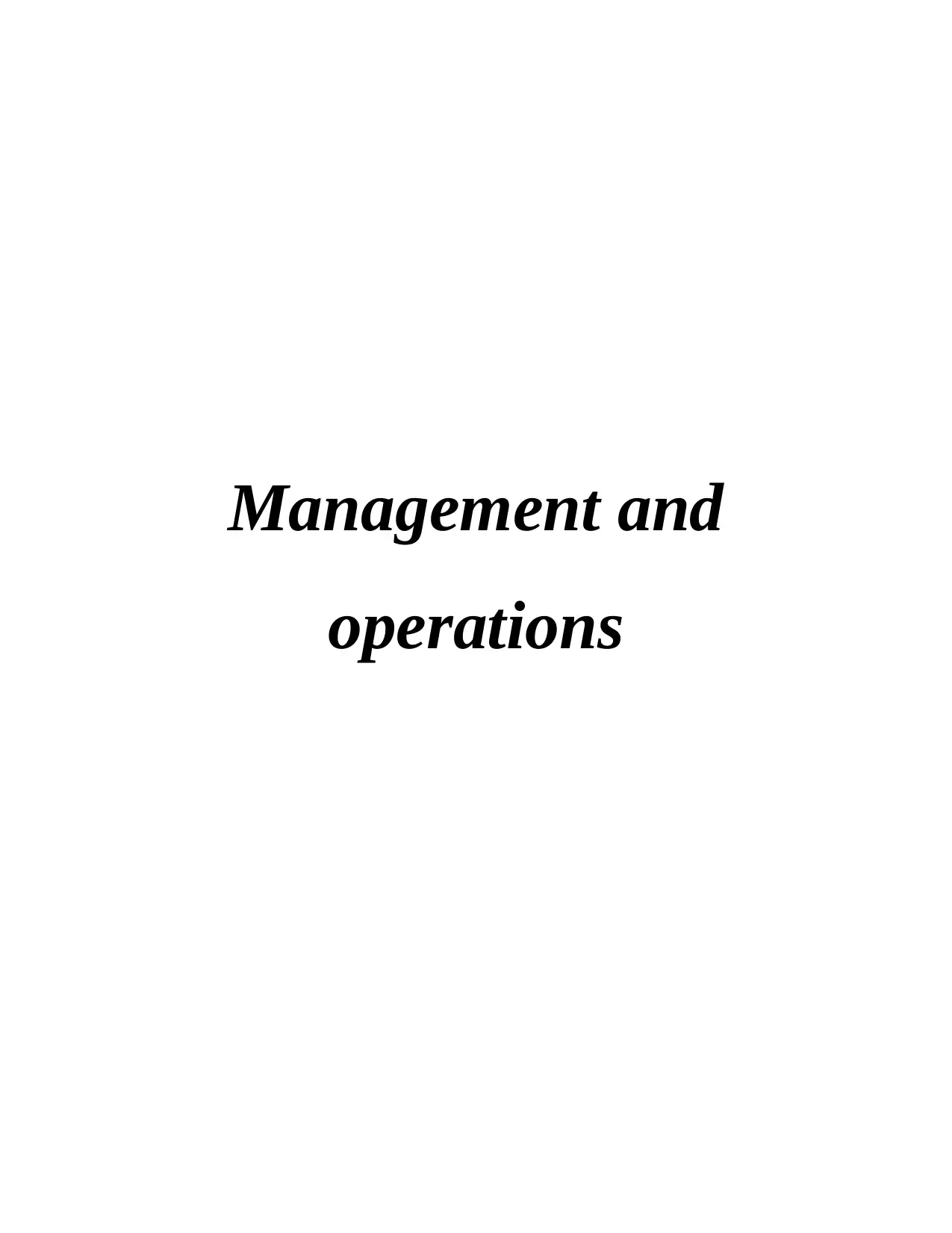
Management and
operations
operations
Paraphrase This Document
Need a fresh take? Get an instant paraphrase of this document with our AI Paraphraser

Table of Contents
INTRODUCTION...........................................................................................................................1
PART 1............................................................................................................................................1
1 Introduction to the organisation and management structure...............................................1
Roles of both managers and leaders, highlighting the differences between management and
leadership................................................................................................................................1
Explanation and analysis of the different roles of management and leadership in application to
different organisational situations..........................................................................................2
Critically analyse the different theories and approaches to leadership..................................3
Conclusions and recommendations for future developments.................................................5
PART 2............................................................................................................................................5
Introduction to the key operations of the business enterprise................................................5
Details of each of the key operational functions, identifying the roles and responsibilities of
managers.................................................................................................................................6
Explanation of the key operational approaches to operations management and their value..6
An evaluation of the impact of external business environment factors that affect decision
making by leaders and managers............................................................................................7
An evaluation of how operational efficiencies can be improved to successfully meet business
objectives using appropriate management and leadership approaches..................................8
Conclusions and supported recommendations for future improvements...............................8
REFERENCES .............................................................................................................................10
INTRODUCTION...........................................................................................................................1
PART 1............................................................................................................................................1
1 Introduction to the organisation and management structure...............................................1
Roles of both managers and leaders, highlighting the differences between management and
leadership................................................................................................................................1
Explanation and analysis of the different roles of management and leadership in application to
different organisational situations..........................................................................................2
Critically analyse the different theories and approaches to leadership..................................3
Conclusions and recommendations for future developments.................................................5
PART 2............................................................................................................................................5
Introduction to the key operations of the business enterprise................................................5
Details of each of the key operational functions, identifying the roles and responsibilities of
managers.................................................................................................................................6
Explanation of the key operational approaches to operations management and their value..6
An evaluation of the impact of external business environment factors that affect decision
making by leaders and managers............................................................................................7
An evaluation of how operational efficiencies can be improved to successfully meet business
objectives using appropriate management and leadership approaches..................................8
Conclusions and supported recommendations for future improvements...............................8
REFERENCES .............................................................................................................................10

⊘ This is a preview!⊘
Do you want full access?
Subscribe today to unlock all pages.

Trusted by 1+ million students worldwide

INTRODUCTION
Operations management is termed zone of management that is concerned to controlling
and designing organisational production process. It also supports in redesigning of operational
activities at the time of developing products and services (What is Operations Management,
2014). The main role of management of every company is to effectively organise its operational
activities and perform planning in such a manner so that their organisational goals and objective
could be attained within provided time frame (Kotter, 2013). In the current project Ford Motors
has been taken into consideration in order to develop knowledge on operations management.
Ford motors was incorporated in the year 1903 and headquartered in Michigan, U.S. The
company belongs to auto mobile sector which also offers commercial vehicles worldwide. The
present report is divided into two main parts which also has various sub sections. It will cover
information on role of leaders and manager along with their difference. Later, their roles in
handling different organisational situation is explained. Also, different approaches of leadership
will be addressed. Further, it will also explain about key operations of company. At last,
explanation will be going to be given on the influence of operational management as well as on
decision making of manager.
PART 1
1 Introduction to the organisation and management structure
Ford motors is the second largest auto maker of US which provides basically commercial
vehicles and sells auto-mobiles across the world. As the company has presence at international
market scale it has huge workforce which tackles their business activities effectively. It has
approximately 199000 employees who manages different outlets worldwide. Administration
department of Ford Motors have various divisional units and departments according to regional
market place (LaGanga, 2011). The main divisional unit of this company are Asia Pacific, The
Americas, Europe, Africa and Middle East.
Roles of both managers and leaders, highlighting the differences between management and
leadership
Managers are identified as the person who is constantly engaged in scheming and
developing organisational work in such a manner so that they can accomplished in quick manner.
Their main role in the company is to assign work to employees according to their skills and
1
Operations management is termed zone of management that is concerned to controlling
and designing organisational production process. It also supports in redesigning of operational
activities at the time of developing products and services (What is Operations Management,
2014). The main role of management of every company is to effectively organise its operational
activities and perform planning in such a manner so that their organisational goals and objective
could be attained within provided time frame (Kotter, 2013). In the current project Ford Motors
has been taken into consideration in order to develop knowledge on operations management.
Ford motors was incorporated in the year 1903 and headquartered in Michigan, U.S. The
company belongs to auto mobile sector which also offers commercial vehicles worldwide. The
present report is divided into two main parts which also has various sub sections. It will cover
information on role of leaders and manager along with their difference. Later, their roles in
handling different organisational situation is explained. Also, different approaches of leadership
will be addressed. Further, it will also explain about key operations of company. At last,
explanation will be going to be given on the influence of operational management as well as on
decision making of manager.
PART 1
1 Introduction to the organisation and management structure
Ford motors is the second largest auto maker of US which provides basically commercial
vehicles and sells auto-mobiles across the world. As the company has presence at international
market scale it has huge workforce which tackles their business activities effectively. It has
approximately 199000 employees who manages different outlets worldwide. Administration
department of Ford Motors have various divisional units and departments according to regional
market place (LaGanga, 2011). The main divisional unit of this company are Asia Pacific, The
Americas, Europe, Africa and Middle East.
Roles of both managers and leaders, highlighting the differences between management and
leadership
Managers are identified as the person who is constantly engaged in scheming and
developing organisational work in such a manner so that they can accomplished in quick manner.
Their main role in the company is to assign work to employees according to their skills and
1
Paraphrase This Document
Need a fresh take? Get an instant paraphrase of this document with our AI Paraphraser
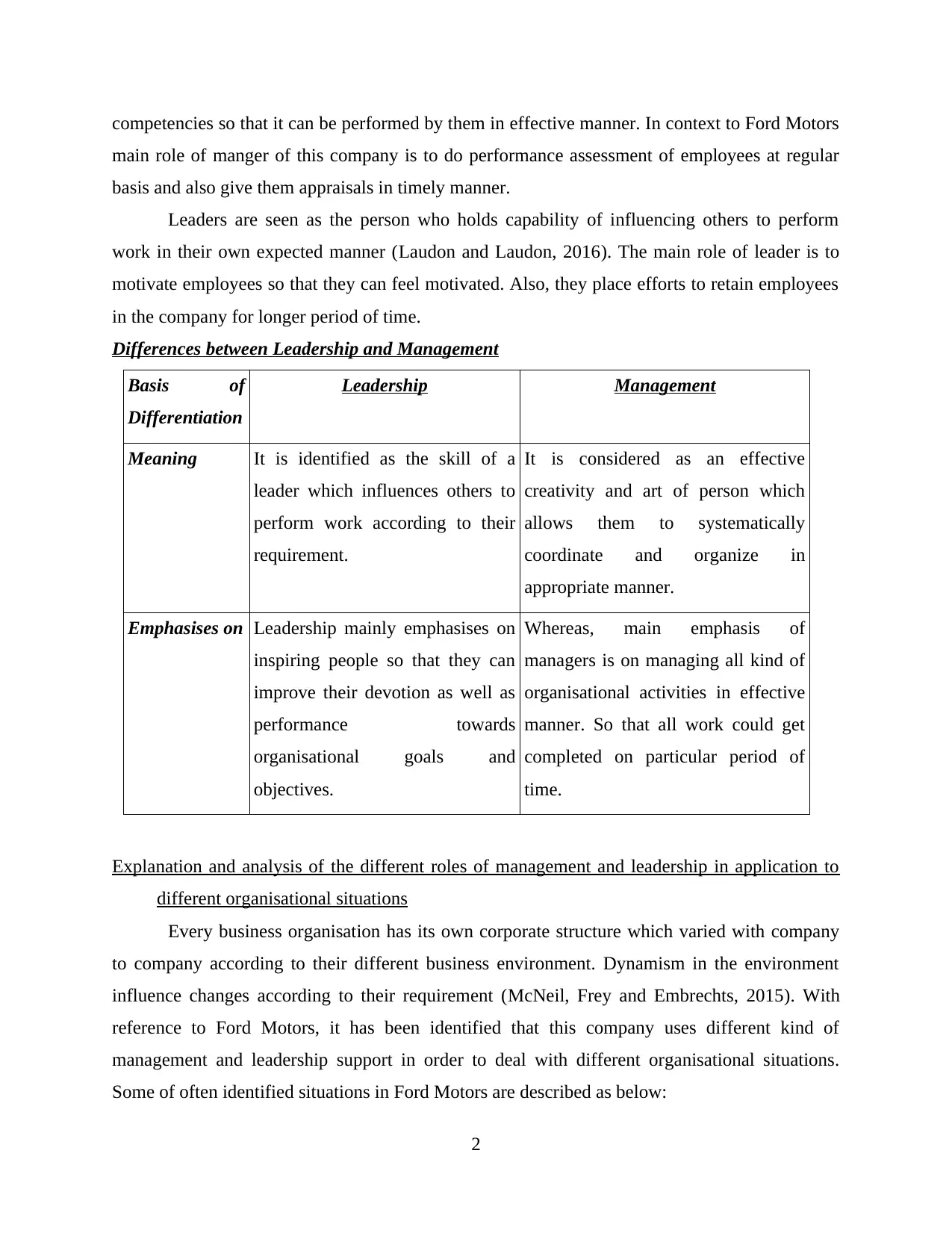
competencies so that it can be performed by them in effective manner. In context to Ford Motors
main role of manger of this company is to do performance assessment of employees at regular
basis and also give them appraisals in timely manner.
Leaders are seen as the person who holds capability of influencing others to perform
work in their own expected manner (Laudon and Laudon, 2016). The main role of leader is to
motivate employees so that they can feel motivated. Also, they place efforts to retain employees
in the company for longer period of time.
Differences between Leadership and Management
Basis of
Differentiation
Leadership Management
Meaning It is identified as the skill of a
leader which influences others to
perform work according to their
requirement.
It is considered as an effective
creativity and art of person which
allows them to systematically
coordinate and organize in
appropriate manner.
Emphasises on Leadership mainly emphasises on
inspiring people so that they can
improve their devotion as well as
performance towards
organisational goals and
objectives.
Whereas, main emphasis of
managers is on managing all kind of
organisational activities in effective
manner. So that all work could get
completed on particular period of
time.
Explanation and analysis of the different roles of management and leadership in application to
different organisational situations
Every business organisation has its own corporate structure which varied with company
to company according to their different business environment. Dynamism in the environment
influence changes according to their requirement (McNeil, Frey and Embrechts, 2015). With
reference to Ford Motors, it has been identified that this company uses different kind of
management and leadership support in order to deal with different organisational situations.
Some of often identified situations in Ford Motors are described as below:
2
main role of manger of this company is to do performance assessment of employees at regular
basis and also give them appraisals in timely manner.
Leaders are seen as the person who holds capability of influencing others to perform
work in their own expected manner (Laudon and Laudon, 2016). The main role of leader is to
motivate employees so that they can feel motivated. Also, they place efforts to retain employees
in the company for longer period of time.
Differences between Leadership and Management
Basis of
Differentiation
Leadership Management
Meaning It is identified as the skill of a
leader which influences others to
perform work according to their
requirement.
It is considered as an effective
creativity and art of person which
allows them to systematically
coordinate and organize in
appropriate manner.
Emphasises on Leadership mainly emphasises on
inspiring people so that they can
improve their devotion as well as
performance towards
organisational goals and
objectives.
Whereas, main emphasis of
managers is on managing all kind of
organisational activities in effective
manner. So that all work could get
completed on particular period of
time.
Explanation and analysis of the different roles of management and leadership in application to
different organisational situations
Every business organisation has its own corporate structure which varied with company
to company according to their different business environment. Dynamism in the environment
influence changes according to their requirement (McNeil, Frey and Embrechts, 2015). With
reference to Ford Motors, it has been identified that this company uses different kind of
management and leadership support in order to deal with different organisational situations.
Some of often identified situations in Ford Motors are described as below:
2

Decision making: Working life in Ford Motor includes designing, producing and then
selling of vehicles at market. In order to implement this manager as well as leaders have to take
crucial decision so that every work could be implemented effectively in the company. Herein,
role of manager is to analyse all of the needs and requirements of employees so that they can
effectively motivate them in order to improve their performance. Whereas, role of leader is to
adopt participative leadership style in order to engage employees in their every essential decision
making procedure (Mollenkopf, Frankel and Russo, 2011). This will support in encouraging
employees to reflect their own ideas for organisational development. Efforts of both managers
and leaders will ultimately lead to enhancement of organisational productivity that will lead to
quick attainment of company's objectives in quick manner.
Employee engagement: It is identified as an essential activity in the company. In this
employees are engaged in every important activity and procedure. It is identified as the situation
in which managers willing conducts various meetings and conferences in Ford Motors at regular
basis so that everyone gets chance to represent their views and opinions in front of management.
Role of leader is to appreciate out performers for their extra ordinary performance by providing
them rewards. In order to attain organisational goals and objectives in quicker manner managers
as well as leaders works collaboratively for improving efficiency of employees.
Technology up-gradation: While taking example of technological up-gradation as an
another situation in Ford Motors is best for understanding role of leader and manager in the
company. In this, manager of Ford Motors takes help of effective technological equipment’s so
that employees can easily execute their work responsibility in effective manner (Nassiri and et.
al., 2016). This ultimately creates requirement of development of skills among employees so that
they can use these technological tools in order to execute their business work in right manner.
Moreover, leaders prefer to personally give training to each and every employee in order to
develop their skills according to the implemented technology which directly leads to execution
of organisational work in effective manner.
Critically analyse the different theories and approaches to leadership
There are numerous of theories and frameworks which are used by business associations
like approaches for the purpose of enhancing functioning company. Some of the approaches that
are used by Ford Motors are described as below:
3
selling of vehicles at market. In order to implement this manager as well as leaders have to take
crucial decision so that every work could be implemented effectively in the company. Herein,
role of manager is to analyse all of the needs and requirements of employees so that they can
effectively motivate them in order to improve their performance. Whereas, role of leader is to
adopt participative leadership style in order to engage employees in their every essential decision
making procedure (Mollenkopf, Frankel and Russo, 2011). This will support in encouraging
employees to reflect their own ideas for organisational development. Efforts of both managers
and leaders will ultimately lead to enhancement of organisational productivity that will lead to
quick attainment of company's objectives in quick manner.
Employee engagement: It is identified as an essential activity in the company. In this
employees are engaged in every important activity and procedure. It is identified as the situation
in which managers willing conducts various meetings and conferences in Ford Motors at regular
basis so that everyone gets chance to represent their views and opinions in front of management.
Role of leader is to appreciate out performers for their extra ordinary performance by providing
them rewards. In order to attain organisational goals and objectives in quicker manner managers
as well as leaders works collaboratively for improving efficiency of employees.
Technology up-gradation: While taking example of technological up-gradation as an
another situation in Ford Motors is best for understanding role of leader and manager in the
company. In this, manager of Ford Motors takes help of effective technological equipment’s so
that employees can easily execute their work responsibility in effective manner (Nassiri and et.
al., 2016). This ultimately creates requirement of development of skills among employees so that
they can use these technological tools in order to execute their business work in right manner.
Moreover, leaders prefer to personally give training to each and every employee in order to
develop their skills according to the implemented technology which directly leads to execution
of organisational work in effective manner.
Critically analyse the different theories and approaches to leadership
There are numerous of theories and frameworks which are used by business associations
like approaches for the purpose of enhancing functioning company. Some of the approaches that
are used by Ford Motors are described as below:
3
⊘ This is a preview!⊘
Do you want full access?
Subscribe today to unlock all pages.

Trusted by 1+ million students worldwide
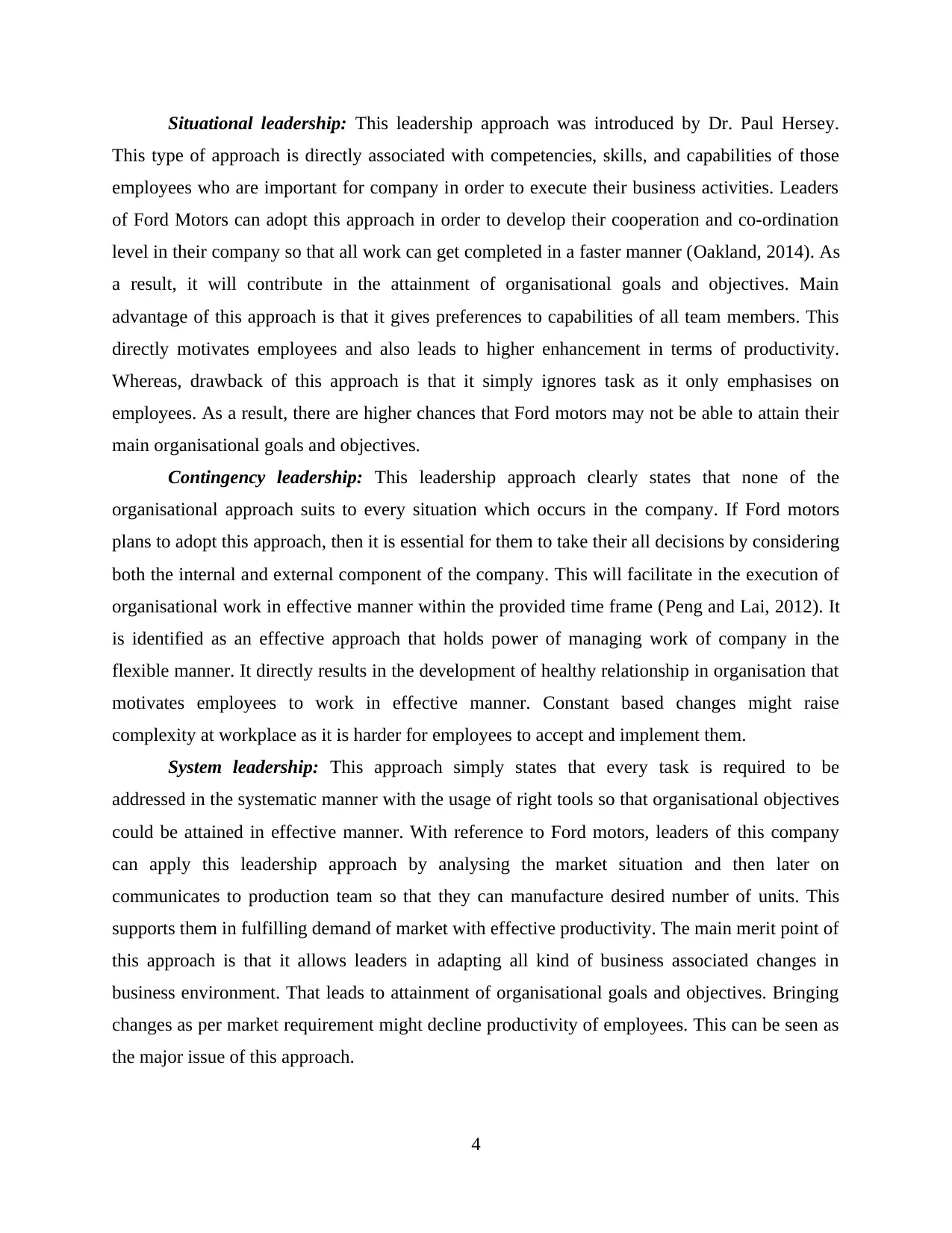
Situational leadership: This leadership approach was introduced by Dr. Paul Hersey.
This type of approach is directly associated with competencies, skills, and capabilities of those
employees who are important for company in order to execute their business activities. Leaders
of Ford Motors can adopt this approach in order to develop their cooperation and co-ordination
level in their company so that all work can get completed in a faster manner (Oakland, 2014). As
a result, it will contribute in the attainment of organisational goals and objectives. Main
advantage of this approach is that it gives preferences to capabilities of all team members. This
directly motivates employees and also leads to higher enhancement in terms of productivity.
Whereas, drawback of this approach is that it simply ignores task as it only emphasises on
employees. As a result, there are higher chances that Ford motors may not be able to attain their
main organisational goals and objectives.
Contingency leadership: This leadership approach clearly states that none of the
organisational approach suits to every situation which occurs in the company. If Ford motors
plans to adopt this approach, then it is essential for them to take their all decisions by considering
both the internal and external component of the company. This will facilitate in the execution of
organisational work in effective manner within the provided time frame (Peng and Lai, 2012). It
is identified as an effective approach that holds power of managing work of company in the
flexible manner. It directly results in the development of healthy relationship in organisation that
motivates employees to work in effective manner. Constant based changes might raise
complexity at workplace as it is harder for employees to accept and implement them.
System leadership: This approach simply states that every task is required to be
addressed in the systematic manner with the usage of right tools so that organisational objectives
could be attained in effective manner. With reference to Ford motors, leaders of this company
can apply this leadership approach by analysing the market situation and then later on
communicates to production team so that they can manufacture desired number of units. This
supports them in fulfilling demand of market with effective productivity. The main merit point of
this approach is that it allows leaders in adapting all kind of business associated changes in
business environment. That leads to attainment of organisational goals and objectives. Bringing
changes as per market requirement might decline productivity of employees. This can be seen as
the major issue of this approach.
4
This type of approach is directly associated with competencies, skills, and capabilities of those
employees who are important for company in order to execute their business activities. Leaders
of Ford Motors can adopt this approach in order to develop their cooperation and co-ordination
level in their company so that all work can get completed in a faster manner (Oakland, 2014). As
a result, it will contribute in the attainment of organisational goals and objectives. Main
advantage of this approach is that it gives preferences to capabilities of all team members. This
directly motivates employees and also leads to higher enhancement in terms of productivity.
Whereas, drawback of this approach is that it simply ignores task as it only emphasises on
employees. As a result, there are higher chances that Ford motors may not be able to attain their
main organisational goals and objectives.
Contingency leadership: This leadership approach clearly states that none of the
organisational approach suits to every situation which occurs in the company. If Ford motors
plans to adopt this approach, then it is essential for them to take their all decisions by considering
both the internal and external component of the company. This will facilitate in the execution of
organisational work in effective manner within the provided time frame (Peng and Lai, 2012). It
is identified as an effective approach that holds power of managing work of company in the
flexible manner. It directly results in the development of healthy relationship in organisation that
motivates employees to work in effective manner. Constant based changes might raise
complexity at workplace as it is harder for employees to accept and implement them.
System leadership: This approach simply states that every task is required to be
addressed in the systematic manner with the usage of right tools so that organisational objectives
could be attained in effective manner. With reference to Ford motors, leaders of this company
can apply this leadership approach by analysing the market situation and then later on
communicates to production team so that they can manufacture desired number of units. This
supports them in fulfilling demand of market with effective productivity. The main merit point of
this approach is that it allows leaders in adapting all kind of business associated changes in
business environment. That leads to attainment of organisational goals and objectives. Bringing
changes as per market requirement might decline productivity of employees. This can be seen as
the major issue of this approach.
4
Paraphrase This Document
Need a fresh take? Get an instant paraphrase of this document with our AI Paraphraser
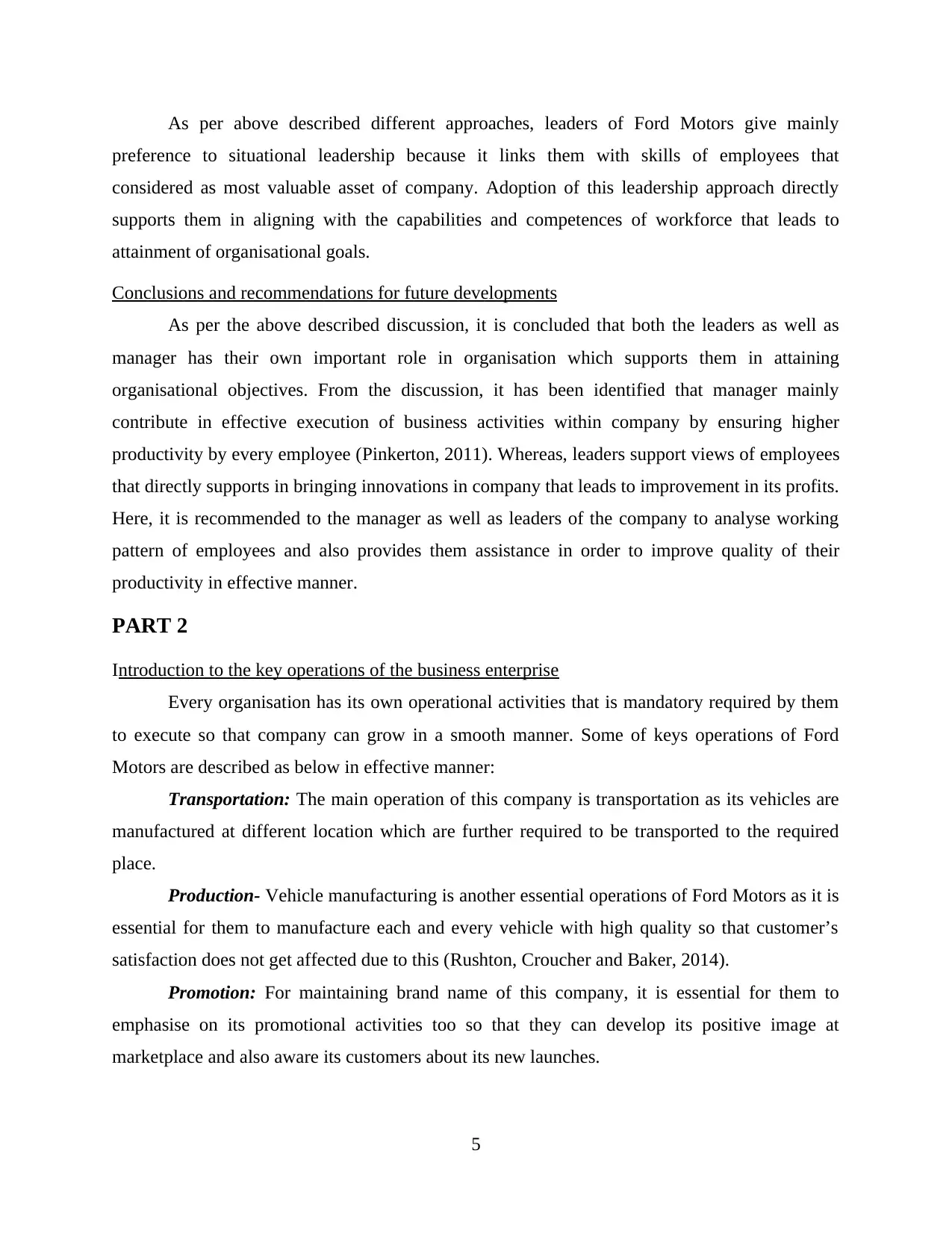
As per above described different approaches, leaders of Ford Motors give mainly
preference to situational leadership because it links them with skills of employees that
considered as most valuable asset of company. Adoption of this leadership approach directly
supports them in aligning with the capabilities and competences of workforce that leads to
attainment of organisational goals.
Conclusions and recommendations for future developments
As per the above described discussion, it is concluded that both the leaders as well as
manager has their own important role in organisation which supports them in attaining
organisational objectives. From the discussion, it has been identified that manager mainly
contribute in effective execution of business activities within company by ensuring higher
productivity by every employee (Pinkerton, 2011). Whereas, leaders support views of employees
that directly supports in bringing innovations in company that leads to improvement in its profits.
Here, it is recommended to the manager as well as leaders of the company to analyse working
pattern of employees and also provides them assistance in order to improve quality of their
productivity in effective manner.
PART 2
Introduction to the key operations of the business enterprise
Every organisation has its own operational activities that is mandatory required by them
to execute so that company can grow in a smooth manner. Some of keys operations of Ford
Motors are described as below in effective manner:
Transportation: The main operation of this company is transportation as its vehicles are
manufactured at different location which are further required to be transported to the required
place.
Production- Vehicle manufacturing is another essential operations of Ford Motors as it is
essential for them to manufacture each and every vehicle with high quality so that customer’s
satisfaction does not get affected due to this (Rushton, Croucher and Baker, 2014).
Promotion: For maintaining brand name of this company, it is essential for them to
emphasise on its promotional activities too so that they can develop its positive image at
marketplace and also aware its customers about its new launches.
5
preference to situational leadership because it links them with skills of employees that
considered as most valuable asset of company. Adoption of this leadership approach directly
supports them in aligning with the capabilities and competences of workforce that leads to
attainment of organisational goals.
Conclusions and recommendations for future developments
As per the above described discussion, it is concluded that both the leaders as well as
manager has their own important role in organisation which supports them in attaining
organisational objectives. From the discussion, it has been identified that manager mainly
contribute in effective execution of business activities within company by ensuring higher
productivity by every employee (Pinkerton, 2011). Whereas, leaders support views of employees
that directly supports in bringing innovations in company that leads to improvement in its profits.
Here, it is recommended to the manager as well as leaders of the company to analyse working
pattern of employees and also provides them assistance in order to improve quality of their
productivity in effective manner.
PART 2
Introduction to the key operations of the business enterprise
Every organisation has its own operational activities that is mandatory required by them
to execute so that company can grow in a smooth manner. Some of keys operations of Ford
Motors are described as below in effective manner:
Transportation: The main operation of this company is transportation as its vehicles are
manufactured at different location which are further required to be transported to the required
place.
Production- Vehicle manufacturing is another essential operations of Ford Motors as it is
essential for them to manufacture each and every vehicle with high quality so that customer’s
satisfaction does not get affected due to this (Rushton, Croucher and Baker, 2014).
Promotion: For maintaining brand name of this company, it is essential for them to
emphasise on its promotional activities too so that they can develop its positive image at
marketplace and also aware its customers about its new launches.
5
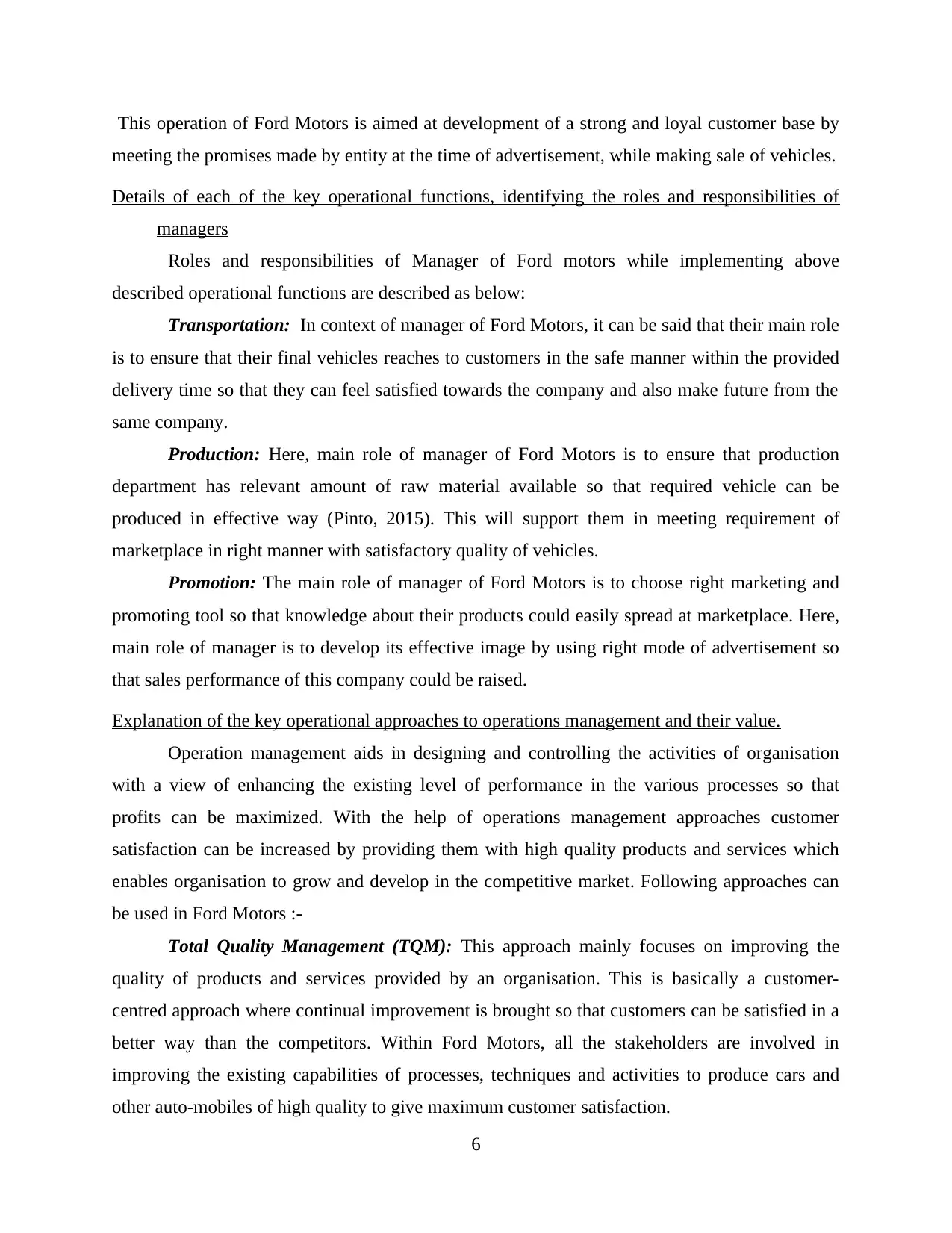
This operation of Ford Motors is aimed at development of a strong and loyal customer base by
meeting the promises made by entity at the time of advertisement, while making sale of vehicles.
Details of each of the key operational functions, identifying the roles and responsibilities of
managers
Roles and responsibilities of Manager of Ford motors while implementing above
described operational functions are described as below:
Transportation: In context of manager of Ford Motors, it can be said that their main role
is to ensure that their final vehicles reaches to customers in the safe manner within the provided
delivery time so that they can feel satisfied towards the company and also make future from the
same company.
Production: Here, main role of manager of Ford Motors is to ensure that production
department has relevant amount of raw material available so that required vehicle can be
produced in effective way (Pinto, 2015). This will support them in meeting requirement of
marketplace in right manner with satisfactory quality of vehicles.
Promotion: The main role of manager of Ford Motors is to choose right marketing and
promoting tool so that knowledge about their products could easily spread at marketplace. Here,
main role of manager is to develop its effective image by using right mode of advertisement so
that sales performance of this company could be raised.
Explanation of the key operational approaches to operations management and their value.
Operation management aids in designing and controlling the activities of organisation
with a view of enhancing the existing level of performance in the various processes so that
profits can be maximized. With the help of operations management approaches customer
satisfaction can be increased by providing them with high quality products and services which
enables organisation to grow and develop in the competitive market. Following approaches can
be used in Ford Motors :-
Total Quality Management (TQM): This approach mainly focuses on improving the
quality of products and services provided by an organisation. This is basically a customer-
centred approach where continual improvement is brought so that customers can be satisfied in a
better way than the competitors. Within Ford Motors, all the stakeholders are involved in
improving the existing capabilities of processes, techniques and activities to produce cars and
other auto-mobiles of high quality to give maximum customer satisfaction.
6
meeting the promises made by entity at the time of advertisement, while making sale of vehicles.
Details of each of the key operational functions, identifying the roles and responsibilities of
managers
Roles and responsibilities of Manager of Ford motors while implementing above
described operational functions are described as below:
Transportation: In context of manager of Ford Motors, it can be said that their main role
is to ensure that their final vehicles reaches to customers in the safe manner within the provided
delivery time so that they can feel satisfied towards the company and also make future from the
same company.
Production: Here, main role of manager of Ford Motors is to ensure that production
department has relevant amount of raw material available so that required vehicle can be
produced in effective way (Pinto, 2015). This will support them in meeting requirement of
marketplace in right manner with satisfactory quality of vehicles.
Promotion: The main role of manager of Ford Motors is to choose right marketing and
promoting tool so that knowledge about their products could easily spread at marketplace. Here,
main role of manager is to develop its effective image by using right mode of advertisement so
that sales performance of this company could be raised.
Explanation of the key operational approaches to operations management and their value.
Operation management aids in designing and controlling the activities of organisation
with a view of enhancing the existing level of performance in the various processes so that
profits can be maximized. With the help of operations management approaches customer
satisfaction can be increased by providing them with high quality products and services which
enables organisation to grow and develop in the competitive market. Following approaches can
be used in Ford Motors :-
Total Quality Management (TQM): This approach mainly focuses on improving the
quality of products and services provided by an organisation. This is basically a customer-
centred approach where continual improvement is brought so that customers can be satisfied in a
better way than the competitors. Within Ford Motors, all the stakeholders are involved in
improving the existing capabilities of processes, techniques and activities to produce cars and
other auto-mobiles of high quality to give maximum customer satisfaction.
6
⊘ This is a preview!⊘
Do you want full access?
Subscribe today to unlock all pages.

Trusted by 1+ million students worldwide

Six-Sigma: It is a statistical and data driven approach which can help in improving the
exiting level of performance of system by eliminating the number of defects and differences in
products and services so that uniformity can be maintained. This approach needs the involvement
of all the personnel so that defects can be detected at all the levels to ensure delivery of products
with high quality. This results in increased sales and profitability of the business and enhancing
their reputation in the market.
(Source: Six Sigma, 2016)
Just in time: It is related with managing the inventory of an organisation by aligning raw
material orders from suppliers with respect to the production schedules of the company which is
related with the market demand. This helps in dealing with work in progress and the remaining
stocks (Rani and Moreira, 2010). This helps the organisations in dealing with the storage costs of
inventory and acquiring required items from suppliers as and when required.
An evaluation of the impact of external business environment factors that affect decision making
by leaders and managers
Various external factors affect the strategies that are formulated by the leaders and
managers of an organisation that influence its performance and efficiency in achieving its goals
and objectives. These factors affect decision-making of leaders and managers in the following
manner:
External Factors: These factors cannot be controlled or changed, rather these are to be
dealt with by formulating policies and strategies by managers.
7
Illustration 1: Six Sigma
exiting level of performance of system by eliminating the number of defects and differences in
products and services so that uniformity can be maintained. This approach needs the involvement
of all the personnel so that defects can be detected at all the levels to ensure delivery of products
with high quality. This results in increased sales and profitability of the business and enhancing
their reputation in the market.
(Source: Six Sigma, 2016)
Just in time: It is related with managing the inventory of an organisation by aligning raw
material orders from suppliers with respect to the production schedules of the company which is
related with the market demand. This helps in dealing with work in progress and the remaining
stocks (Rani and Moreira, 2010). This helps the organisations in dealing with the storage costs of
inventory and acquiring required items from suppliers as and when required.
An evaluation of the impact of external business environment factors that affect decision making
by leaders and managers
Various external factors affect the strategies that are formulated by the leaders and
managers of an organisation that influence its performance and efficiency in achieving its goals
and objectives. These factors affect decision-making of leaders and managers in the following
manner:
External Factors: These factors cannot be controlled or changed, rather these are to be
dealt with by formulating policies and strategies by managers.
7
Illustration 1: Six Sigma
Paraphrase This Document
Need a fresh take? Get an instant paraphrase of this document with our AI Paraphraser
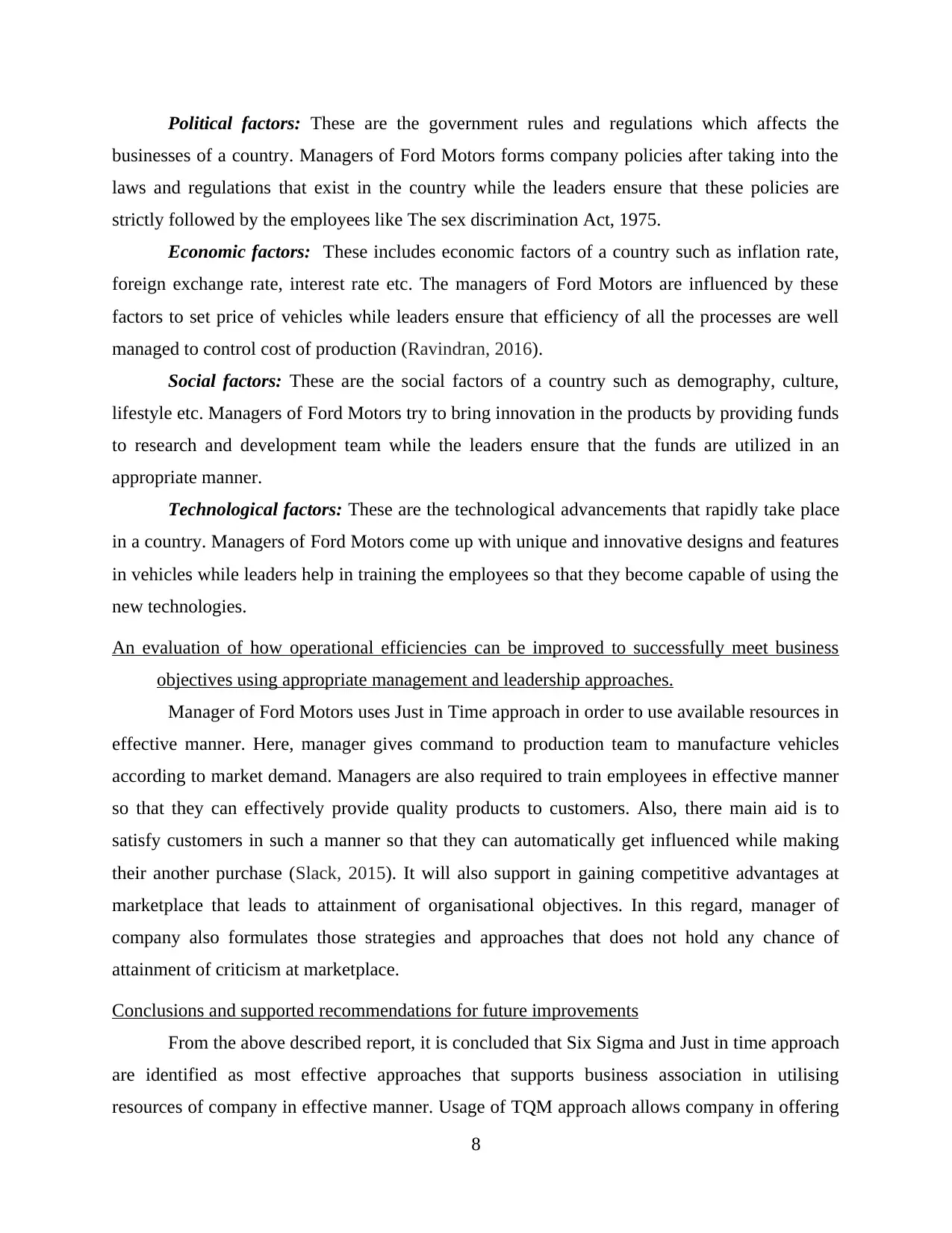
Political factors: These are the government rules and regulations which affects the
businesses of a country. Managers of Ford Motors forms company policies after taking into the
laws and regulations that exist in the country while the leaders ensure that these policies are
strictly followed by the employees like The sex discrimination Act, 1975.
Economic factors: These includes economic factors of a country such as inflation rate,
foreign exchange rate, interest rate etc. The managers of Ford Motors are influenced by these
factors to set price of vehicles while leaders ensure that efficiency of all the processes are well
managed to control cost of production (Ravindran, 2016).
Social factors: These are the social factors of a country such as demography, culture,
lifestyle etc. Managers of Ford Motors try to bring innovation in the products by providing funds
to research and development team while the leaders ensure that the funds are utilized in an
appropriate manner.
Technological factors: These are the technological advancements that rapidly take place
in a country. Managers of Ford Motors come up with unique and innovative designs and features
in vehicles while leaders help in training the employees so that they become capable of using the
new technologies.
An evaluation of how operational efficiencies can be improved to successfully meet business
objectives using appropriate management and leadership approaches.
Manager of Ford Motors uses Just in Time approach in order to use available resources in
effective manner. Here, manager gives command to production team to manufacture vehicles
according to market demand. Managers are also required to train employees in effective manner
so that they can effectively provide quality products to customers. Also, there main aid is to
satisfy customers in such a manner so that they can automatically get influenced while making
their another purchase (Slack, 2015). It will also support in gaining competitive advantages at
marketplace that leads to attainment of organisational objectives. In this regard, manager of
company also formulates those strategies and approaches that does not hold any chance of
attainment of criticism at marketplace.
Conclusions and supported recommendations for future improvements
From the above described report, it is concluded that Six Sigma and Just in time approach
are identified as most effective approaches that supports business association in utilising
resources of company in effective manner. Usage of TQM approach allows company in offering
8
businesses of a country. Managers of Ford Motors forms company policies after taking into the
laws and regulations that exist in the country while the leaders ensure that these policies are
strictly followed by the employees like The sex discrimination Act, 1975.
Economic factors: These includes economic factors of a country such as inflation rate,
foreign exchange rate, interest rate etc. The managers of Ford Motors are influenced by these
factors to set price of vehicles while leaders ensure that efficiency of all the processes are well
managed to control cost of production (Ravindran, 2016).
Social factors: These are the social factors of a country such as demography, culture,
lifestyle etc. Managers of Ford Motors try to bring innovation in the products by providing funds
to research and development team while the leaders ensure that the funds are utilized in an
appropriate manner.
Technological factors: These are the technological advancements that rapidly take place
in a country. Managers of Ford Motors come up with unique and innovative designs and features
in vehicles while leaders help in training the employees so that they become capable of using the
new technologies.
An evaluation of how operational efficiencies can be improved to successfully meet business
objectives using appropriate management and leadership approaches.
Manager of Ford Motors uses Just in Time approach in order to use available resources in
effective manner. Here, manager gives command to production team to manufacture vehicles
according to market demand. Managers are also required to train employees in effective manner
so that they can effectively provide quality products to customers. Also, there main aid is to
satisfy customers in such a manner so that they can automatically get influenced while making
their another purchase (Slack, 2015). It will also support in gaining competitive advantages at
marketplace that leads to attainment of organisational objectives. In this regard, manager of
company also formulates those strategies and approaches that does not hold any chance of
attainment of criticism at marketplace.
Conclusions and supported recommendations for future improvements
From the above described report, it is concluded that Six Sigma and Just in time approach
are identified as most effective approaches that supports business association in utilising
resources of company in effective manner. Usage of TQM approach allows company in offering
8

high quality of products to customers. It also allows Ford Motors in improving its brand image
among customers because its offerings are of high quality that directly develops its image among
customers. It has also been identified that Economy, society, laws, political system, ethics,
values are identified as some essential factors which directly places impact over functioning and
operational activity of company. Both the leaders and manager has very significant role in
company. Thus, there is the huge requirement of their corporation so that its goal and objective
could be attained in quicker manner.
9
among customers because its offerings are of high quality that directly develops its image among
customers. It has also been identified that Economy, society, laws, political system, ethics,
values are identified as some essential factors which directly places impact over functioning and
operational activity of company. Both the leaders and manager has very significant role in
company. Thus, there is the huge requirement of their corporation so that its goal and objective
could be attained in quicker manner.
9
⊘ This is a preview!⊘
Do you want full access?
Subscribe today to unlock all pages.

Trusted by 1+ million students worldwide
1 out of 13
Related Documents
Your All-in-One AI-Powered Toolkit for Academic Success.
+13062052269
info@desklib.com
Available 24*7 on WhatsApp / Email
![[object Object]](/_next/static/media/star-bottom.7253800d.svg)
Unlock your academic potential
Copyright © 2020–2025 A2Z Services. All Rights Reserved. Developed and managed by ZUCOL.





